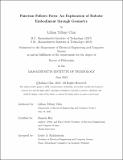Function Follows Form: An Exploration of Robotic Embodiment through Geometry
Author(s)
Chin, Lillian Tiffany
DownloadThesis PDF (29.13Mb)
Advisor
Rus, Daniela
Terms of use
Metadata
Show full item recordAbstract
Current robot designers often treat a robot’s body as merely a vessel to transport the brain, limiting the potential scope of “embodied intelligence” that is unique to robotics. This cognitivist approach to robot design is in-line with critiques from disability studies, which argues that assuming a single normative body ignores the diversity of human body-environment interactions, unfairly limiting human potential.
This thesis aims to use framings from disability studies to better inform robotic design practice. By examining interactions between a body and its environment — whether a human body or a robotic one — we gain a better understanding of the necessary materials and tools needed to make that interaction a successful one. I am particularly interested in using geometry as a design tool for robot bodies, especially given the potential of mechanical metamaterials in robotic design.
After first discussing bodies, materials and geometry’s impact on form in both disability studies and robotics, I demonstrate the power of this approach through two main case studies. First, I introduce AuxBots, a set of modular robots that use a motorized auxetic shell to control their volumetric expansion. Since the AuxBot’s expansion was achieved purely through geometry, I had significant control over the design space. I created AuxBots optimized for speed and expansion ratio (390% volume expansion in 0.2 seconds) or for force output (135 N max, or 76x strength-weight ratio, one of the highest ratios of any modular robot). I was able to explicitly make trade-offs between stiffness, speed, and force as a direct consequence of how the geometric parameters affect the overall system behavior.
My second example is the technique of fluidic innervation, a sensorization strategy that patterns empty air channels within the struts of a 3D printed metamaterial. When the metamaterial deforms, these air channels will have their volume changed, which, by the Ideal Gas Law, can then be measured using an off-the-shelf pressure sensor. This combines perception directly with the underlying geometry of the metamaterial itself, since the channels follow the same structural elements that form the overall metamaterial. When complex metamaterials (ex. handed shearing auxetics) are sensorized, fully proprioceptive soft robotic systems can be created as structure, actuation and sensing are embedded into one single geometry.
These examples demonstrate not only the power of using geometry as a design tool, but also the potential for combining social science approaches for robotic development.
Date issued
2023-06Department
Massachusetts Institute of Technology. Department of Electrical Engineering and Computer SciencePublisher
Massachusetts Institute of Technology